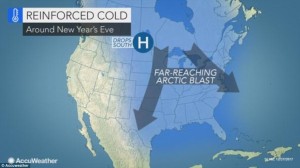Essay by S. Tom Bond, Resident Farmer & Retired Professor, Lewis County, WV
President Trump has famously joked from his Florida trip that much of he U. S. could “use a little global warming” right now. Like many of us he apparently doesn’t know the local Arctic blast is a part of global warming.
The weather broadcasts are very parochial – that is they are locally oriented. The contiguous U. S. comprises only two percent of the earth’s dry land. That’s where the population is and that is where our TV weather broadcasters devote most of their time.
In fact, even Alaska is warmer than usual, and permafrost is melting, with houses and roads breaking, and shorelines slumping and washing into the ocean. Much of the rest of the country is warmer than expected for this time of year.
The poles are warming about twice as fast as the tropics. In other words, the temperature difference between them is declining. The energy difference driving heat North (and South at the other end of the earth) is declining.
Somewhere between 90 and 95% of the additional heat produced by greenhouse gases goes into the ocean. The air is warmed and it is transferred to the surface of the ocean. There currents carry it away to the depths. Much of the ocean is not warmed yet, however. The heat storage capacity of the ocean is very large.
More heating of the air by greenhouse gases occurs where the surface of the earth is vertical to the incoming sunlight – that is, the tropics, and less is absorbed away from vertical. Heat leaves earth from the polar areas. Consequently, heat is constantly moving toward the poles to be lost into space. With global warming the difference is becoming less. Melting of Arctic ice is a big worry, because more heat can be absorbed there with a dark ocean than with reflective ice and there will be even less difference in temperature between the tropics and the poles.
The Jet Stream is a fast moving river of air at high altitude that is caused by the earth’s rotation. It is a boundary between the mid-latitudes and the more northerly area. It runs about the northern border between the U. S. and Canada. However, it is not a straight line, it has waves, and it’s position varies from time to time. The magnitude of these North-South waves depends on how much energy difference (temperature difference) there is between the tropics and the polar region.
Our thought must now rest on an analogy. The reader may have observed that a stream moving on a slope, a mountainside, goes downhill in a relatively straight line, moving rapidly. In contrast, a stream that is on a sight slope such as along the bottom of a valley or on a plain (as on a plane), the water moves slowly and the stream meanders.
The jet stream is affected the same way. Now that the energy difference between tropics and polar regions is less, it meanders more widely and the meanders move more slowly. Cold air from the North comes further South and stays longer. It is as if the far North has come south to visit new areas.
The result is more frequent cold spells further South than the past, and these are balanced by warm spells further North than in the past. In a few weeks it will be our turn for more unseasonably warm weather.


{ 1 comment… read it below or add one }
Cold chills U.S. shale gas production as heating demand jumps
From Ernest Scheyder, Reuters News Service, January 2, 2018
HOUSTON, TX — Cold weather gripping much of the United States is denting natural gas production in the nation’s shale patches, with output of the heating fuel down more than 20 percent since last month in North Dakota’s Bakken region, according to analyst estimates.
The United States relies more on natural gas than coal for heating and has ramped up exports of liquefied natural gas.
Flows of natural gas on interstate pipelines out of North Dakota dropped to about 1 billion cubic feet per day (bcfd) on Tuesday, down from about 1.3 bcfd on December 25, according to Genscape data. One bcfd is enough gas to fuel about five million U.S. homes.
“That drop is due to the freeze off we’re seeing,” said Andrew Bradford of BTU Analytics, an energy consultancy.
Natural gas production often can be affected by water vapor in pipeline systems freezing and hindering the flow of gas. Unlike crude oil, gas must be piped immediately to a processing facility.
The National Weather Service (NWS) issued wind chill warnings for much of the United States east of the Rocky Mountains on Tuesday.
In Hettinger, North Dakota, temperatures fell to -45°F (-43°C) on Tuesday morning, one of the coldest temperatures recorded on the planet for the day, according to the NWS.
The Genscape data relies on monitoring of interstate pipelines and does not take into account natural gas that may be used in state in power plants or for other uses. Texas and Oklahoma, for example, use most of their natural gas at facilities in state.
In Texas, natural gas transport on interstate pipelines is down about 20 percent. In Oklahoma, the drop is about 22 percent, and in Pennsylvania’s Marcellus shale, the drop is about 5 percent, according to Genscape.
Natural gas demand in the lower 48 U.S. states is expected to reach an all-time high of 144.0 billion cubic feet per day on Tuesday, which would top Monday’s record 142.0 bcfd, according to Reuters data going back to 2008.
(Reporting by Ernest Scheyder; Additional reporting by Liz Hampton in Houston and Scott DiSavino in New York)